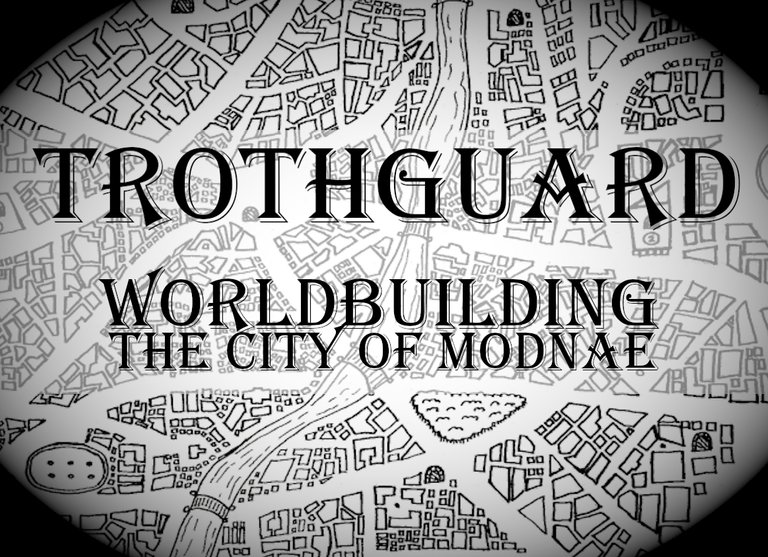
Wow! It's been a WHILE since I did a formal #WorldbuidingWednesday post that wasn't bite-sized content meant to tide you folks over and let you know that I was in fact still making content! Last time I published one of these was all the way back in Aug of 2020, and between then and now I've done some map updates, rambles about cultures, and a quick update on a transit-map based within my world... but none of those were (in my opinion) up to the higher standards I hold this series to, as they didn't show enough of the process to give my readers much by way of inspiration.
My world - Trothguard - is a setting I've created as a catch-all location for any tabletop RPG games I run, so everything I build is filtered through a lens of 'how will this improve the game for myself and my players?'.
Today we're going to look at my process behind Building the City of Modnae.
Modnae is a city that was spawned purely because I created a transit map as a challenge from a friend of mine. Having created the transit map, I knew I had to build a city on top of it to give my random map some use, so I began the process of taking what was essentially a throw-away map and making it into an actual place that I can feature in my games. So, without further ado, let me introduce you to the City of Modnae!
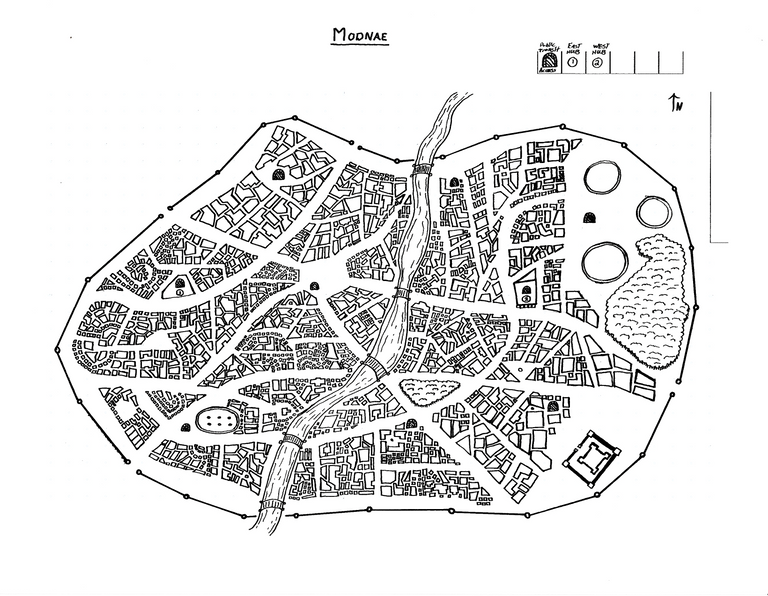 Poorly edited to remove the blue dot grid and sharpen some lines
Poorly edited to remove the blue dot grid and sharpen some linesSince I had made the decision to base the transit around gigantic centipedes that were large enough for people to ride on for public transit, my starting point was to learn some more about centipedes.
Which I guess brings me to my first point about building cities in #ttrpg settings - Make the place memorable!
Odd or unique locations are what players are going to remember. They likely won't remember that the city is named Modnae, but they will likely remember that this is the only city in my setting that features giant centipedes as public transport. Centipede City will, undoubtedly, be a memorable location just based on that one single feature!
So, when you're building your city, the very first thing that I think you should ask yourself is - what makes this place worth visiting? What makes it unique or memorable?
That one choice will inform everything else that you build in this city. In my case, I chose a gimmick. It's not terribly unique within the fantasy/sci-fi genre, but it is unique within my setting. Your 'thing' that you build your city around might not be a gimmick - maybe your 'thing' is an event that happens while players are visiting an otherwise fairly standard generic fantasy city. Maybe your city's 'thing' is not what it has but what it lacks. There are lots of things that can make a city memorable, and if you ever run out of inspiration just pop up some travel guides in Google! See what real cities are promoting as THEIR thing, and let it inspire your fiction!
Now that we've got this core feature, the next real step is to consider how that impacts your city, what it means for the population, and how you can use that as part of your narrative.
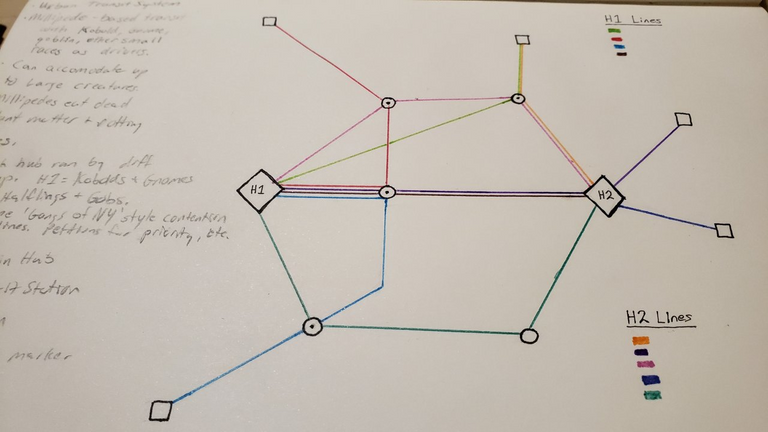
Modnae's Giant Centipede Transit System gives me a number of problems to solve and things to consider. Off the top of my head, some things that I have to think of are:
- How are the giant centipedes bred and where are they kept?
- How are they controlled for public transportation?
- What do they eat, and how is that supplied?
- What, if any, rules or laws are applied to this?
- What caused this system to be created and for what reasons is it still in use?
In my case, because I'm taking inspiration from a real creature, my first order of business is to do some very basic research about my subject. How centipedes mate (and how long it takes for eggs to hatch and for them to mature), what they eat, and other basic facts like that. Once I know how real centipedes work, I can fudge things a bit around the edges to make them fit my world.
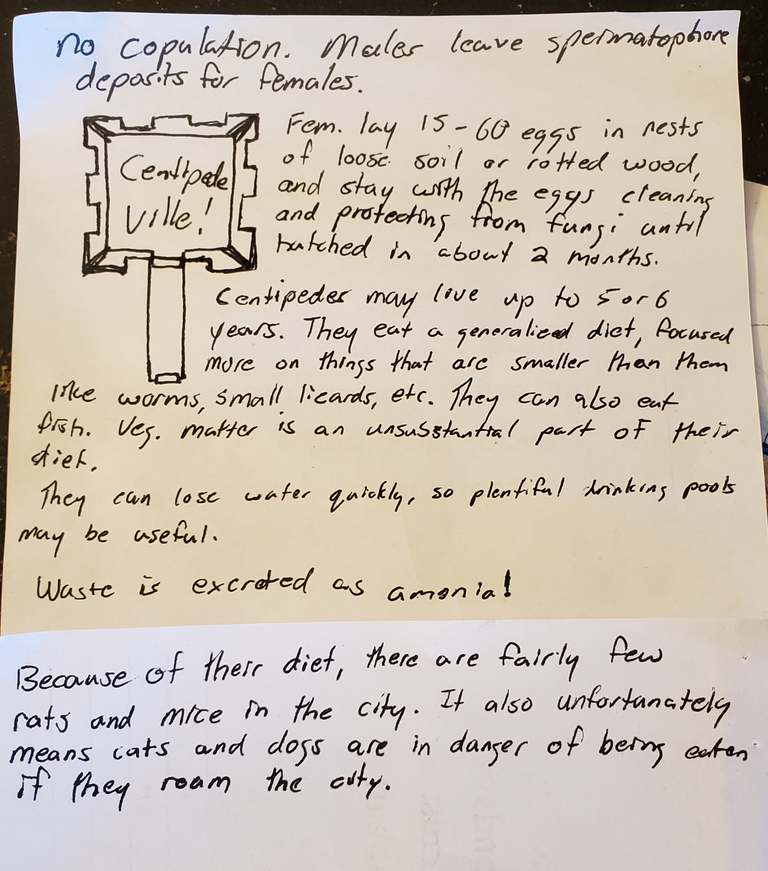
The brief research that I messily jotted down from Wikipedia is a wealth of wonderful things to add to the worldbuilding for this city, as it gives us some timelines and some idea of their diet.
Knowing that they lay, on average, between 15 - 60 eggs and that they take about 2 months to hatch (for the species I was looking at), is pretty useful. Knowing that this species keeps them clean and protected from fungi is also pretty useful as this is a fun little Chekhov's Gun that we'll use later.
Skipping over some of my notes, the next thing to point out here, is that they primarily are meat-eaters. Now, when you scale them up to being big enough to support being transport for a bunch of humans and other big races... that means that they're going to require some big food, and that means we need to have cattle or other large grazing animals.
I didn't look into their metabolism, because for my purpose I don't care how fast they burn through their food and need more in real life. For my purposes and to keep the necessary livestock to a reasonable limit, I'm just going to say that an adult eating a full cow will tide them over for some arbitrary period of time - maybe a full month on that one meal.
Along with food, another thing to note is that they burn through water fairly quickly. That's something that I think is a fun problem so I'm not going to change that very much. As part of the transit loop through the underground caverns, we'll just have a ton of stops to provide some chance to drink.
So, let's go back to the list of questions I asked myself, and see how many of these can be answered.
- How are the giant centipedes bred and where are they kept?
- Special breeding pits for males to leave spermatophore that females can take. Then eggs are deposited in loose soil and rotted wood. So we'll have some woodlands within the city walls to support this.
- How are they controlled for public transportation?
- This one I'm going to lean on magic for. I thought about this one for a while before deciding that the Giant Centipede's drivers sit just behind the head, and use magically enchanted rocks that provide a hot or cold sensation when touched to the creature. Left is a hot stone, right is a cold stone. Both at once low on the body is stop, both at once high on top of the head is 'go faster'. Centipedes chosen to be transporters are trained from the juvenile stage with the rocks and that pattern to ensure they're very used to it.
- What do they eat, and how is that supplied?
- Livestock. A thriving cattle industry supplies the main food source, but they will also cannibalize, and eat any smaller animals they can get. This leads to a very low rodent and stray pet population, as young will regularly eat those smaller creatures whenever they can, and since they are trained on the streets among the crowds to get them used to people, this means they have plenty of time above-ground to snag the odd rodent or stray pet.
- What, if any, rules or laws are applied to this?
- Because of their use as public transport and, to a lesser degree, beasts of burden - it is illegal to kill or harm any of the giant centipedes unless your own life is directly in danger by one. The Breeders Guild has exclusive rights to breeding and selling them, enforced by law. Further, the entire public transport system has a series of laws built around it to protect drivers, passengers, and ordinary citizens... as well as to formalize things like which group has priority access to high-traffic routes during various seasons, holidays, and other such times. This is a hot point of contention between those two groups, and gives me a chance to apply some fun 'Gangs of New York' style rivalries between them!
- What caused this system to be created and for what reasons is it still in use?
- Necessity drove the city to seek help with transport of military items from an eccentric logger's company, who had been using some of the nearby forest's giant centipedes to help with hauling felled trees and processed lumber... and from there, they became more and more popular as freight moving beasts, which eventually evolved into passenger transport.
Now, having answered these and armed with the information from my centipede research, I was able to formulate a plan for my city's map and begin drawing it out. In the end, my finished Version 1 map for this city is:
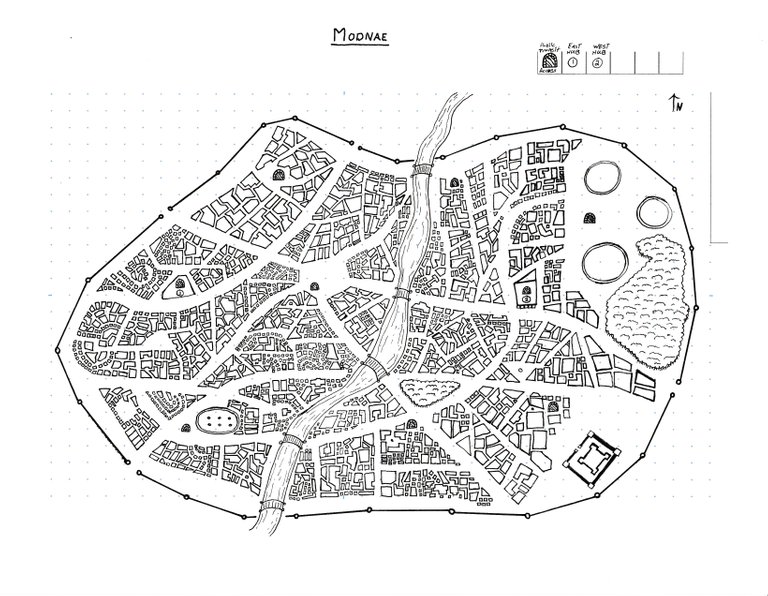 Original scan, un-retouched
Original scan, un-retouchedThe first thing I mapped out and the most important to my city was the 3 circles in the upper north-east which are the pens for males, females and juveniles, and breeding. The large wooded area below that is partly to provide an area for the eggs to be laid and to provide a spot for things like wild rabbits and such so that the hatched young can be fed.
The second thing for me to incorporate was the transit map into the overland map. The observant among you will notice that I messed up my directions and called the east hub 'west' and the west hub 'east' - Gonna blame my newborn and toddler for that as they draw my attention every 5 seconds!
With those two things in place, I added a river cutting the city in half, then went to town on adding buildings. I think the map turned out pretty well for a first try at a fantasy city map.
So, now I have a city with a unique-to-my-world gimmick, some idea of how it'll work and what it takes to supply, and a map for the city. For your own worldbuilding, don't feel like you need to have a map. I did that for myself as cartography and map-making are something I find a lot of enjoyment in.
So, now that I've shown my thought process behind picking a memorable feature, working out how it'd work, and making a map for it... there are just a few other things that we should consider when worldbuilding a city.
In many of my towns and cities that I build, I like to know the following:
- What is the population breakdown? How common are the various races/nationalities/etc?
- How are disputes handled and laws passed? Is there a local noble that handles legal matters? A council? An appointed justice?
- Who keeps the peace? Is there a police force, a military presence, or some form of a militia?
- What are the primary imports and exports?
- What are some notable locations or people in the city?
Now, I'm going to be honest and tell you that for right now I haven't answered all of these questions yet for this city. I have some ideas for all of the points, but nothing is formally decided yet. I'll probably have the city be predominantly human, with the next largest demographic being shared between halflings and gnomes. Then below them, goblins and kobolds, and below that everything else. I personally like to use Matt Colville's method for representing demographics (or something very close to this).
Now - just before I wrap this respectably long blog up, I thought I would take us back to one point that I said we'd touch on but haven't yet. My Chekhov's Gun. The Fungi.
This is the last element of city-building I'll talk about today, that is Adventure Hooks.
The fungi note in my research was an immediate hook inspiration, because I instantly realized I had been handed a potential problem/quest on a silver platter.
Regular fungi would likely not be too much of an issue for these giant creatures, but... this is D&D, and we have monstrous fungi! The Myconid species!! They're generally considered peaceful herbivores that live in the Underdark, but to heck with that, this is a perfect thing to change!
So an easy quest hook for players that you can tailor to just about any level range, is to deal with a colony of Myconid who've been feeding upon the young and/or unhatched eggs. Because of the time and effort put into breeding, training, and using the centipedes, it's a high priority for someone to head into their underground home and deal with them.
In closing, I hope this look at how I build a city and what steps I take to go from 'this is a fun idea' to 'this is something I can place in front of my players' has been inspiring. I hope that seeing how my surface-level research informed both my city and my quest hooks is useful and provides you some ideas for how you can use the same in your games. Next #WorldBuildingWednesday, we might return to Modnae to take a deeper look at the city, and how to develop more quest hooks.
Until next time friends, happy gaming!
Thank you for reading today's #WorldbuildingWednesday! I hope this has provided you with some inspiration!
If there's something else you'd like to ask me about, please do so! I will make every effort to answer it next Wednesday.
| WorldbuildingWednesdays - Prior Posts: | |
|---|---|
| 0: Introduction to WorldbuildingWednesday | 10: Economy & Currency |
| 1: Starting the World | 11: Creating Governments |
| 2: Kingdoms, Factions, and Notable People | 12: Shops & Markets |
| 3: Creation Facts and Creation Myths | 13: Worldbuilding Exercise |
| 4: Shaping History | 14: Legendary Items of Trothguard (Part 1) |
| 5: Myths & Legends | 15: Legendary Items of Trothguard (Part 2) |
| 5.a: Player Visions (Supplemental) | 16: Legendary Items of Trothguard (Part3) |
| 6: Gods & Lesser Deities | |
| 7: Creating Cultures | |
| 8: Making Religions | |
| 9: Building Cults |

Join the Worldbuilding Community!
Very cool! I’ve had a vision of building a works for my DnD players for the longest time but I never know where to start. Gonna take a look at your post history and see if I can’t get inspired.
Awesome! I really hope it helps! It starts a little less well structured than these later posts, but if you come across any questions you'd like to bounce off me just give me a shout and I'd be more than happy to chat about any aspect of ttrpg worldbuilding you're needing a hand with!
I’ll make sure to do that! Thanks!
Love all the thought and detail put into the map.
Along with the process you use from making the place memorable to what kind of daily life is occurring inside of that city along with kind of subjects that are found inside it.
Thank you! I definitely ran out of time to talk about some things with this one as it was getting pretty long, but I wanted to at least touch on everything I find important in building a city. I'll probably do my next post on this place as well just to make sure I've not missed anything.